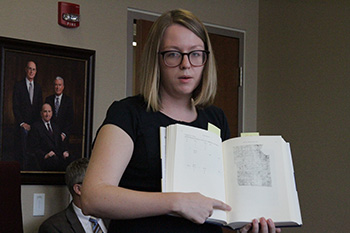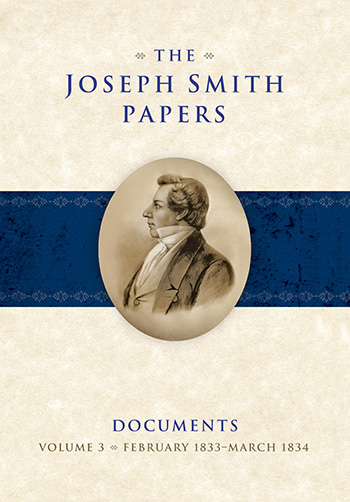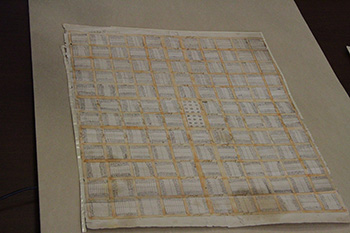Latest Joseph Smith Papers Volume Covers 88 Historical Documents
Contributed By R. Scott Lloyd, Church News staff writer

Gerrit J. Dirkmaat, volume editor, discusses the latest Joseph Smith Papers volume, Documents, Volume 3: February 1833-March 1834.
Related Links
A tumultuous period of Church history in which the Prophet Joseph Smith and other leaders were dealing with the administrative growth of the early Church while coping with oppression and persecution is reflected in the latest printed volume in the Joseph Smith Papers Project.
Documents, Volume 3: February 1833-March 1834, already on the shelves at Deseret Book and other retail outlets, was formally introduced December 1 for bloggers and other interested persons gathered in person and via Internet link at the Church History Library.
“We really have a great diversity in the types of documents that are included in this volume,” said Gerrit J. Dirkmaat, one of five volume editors, regarding the 88 documents that are published in the new book. They include divine revelations—though not so many as in the previous two volumes in the Documents series—correspondence, minutes of meetings in which Joseph participated, licenses provided to Church officers, legal documents, architectural and city plans, and an effort to create a topical guide to the scriptures.
As reflected in the documents, the year 1833 starts out with benign administrative concerns and great hopes reflected in meeting minutes about purchase of property in Kirtland, Ohio. But by the latter part of the year, nearly all of the documents pertain to persecution going on in Kirtland and violence and dispossession of homes and property in Jackson County, Missouri, Brother Dirkmaat said.
A unique document he highlighted was the minutes from the March 18, 1833, meeting, an assembly of high priests in Kirtland. Therein it is recorded that “many of the brethren saw a heavenly vision of the Savior and concourses of angels.”
“This is one of the few times in Church history that we have a contemporary record of what is purported to be a collective, shared, visionary experience,” Brother Dirkmaat remarked, adding that such experiences are usually individual in nature.
Alison Palmer, lead production editor on the volume, said it is the first in the Joseph Smith Papers Project to reproduce architectural plans of temples, or “houses of the Lord,” and city plats.
“We have seven such documents in the volume,” she noted. “Altogether, they demonstrate the role of Joseph Smith and the other Church leaders as temple builders and city planners. Especially, some of the documents show how Joseph Smith and others really saw the unfolding of the establishment of the city of Zion in Jackson County, Missouri.”
Publishing such documents presents a challenge. “Normally, we would just transcribe the text of the document. But these documents are drawings accompanied by notations and measurements and explanations, and, in most cases, the text doesn’t make much sense without the drawing.”
For instance, she displayed a plat of the city of Kirtland dated about June 1833 showing 49 blocks surrounding a center block for a temple, a house for the presidency, and a printing house.
“This document is somewhat large, and to show it we would really have to shrink down the image,” she said. To solve the problem, the drawing was divided into portions reproduced in the book one-by-one with the text transcribed.

Alison Palmer, editorial staff, explains how photos of documents are printed in the latest Joseph Smith Papers volume. Photo by R. Scott Lloyd.

Documents, Volume 3 of the Joseph Smith Papers focuses on documents related to Joseph Smith from February 1833 to March 1834. Image courtesy Church History Library.

The revised plat of the city of Zion in Jackson County, Missouri (June 1833) is one of the documents contained in the latest Joseph Smith Papers volume. Photo by R. Scott Lloyd.
“They are all interesting documents, especially the revised plat of the city of Zion, the revised plan of the house of the Lord, and the proposal for the Zion city center, [which] were all created around August and September of 1833, when persecution and opposition in Jackson County, Missouri, was really heating up,” she said. “They had been forced to sign the agreement to leave Jackson County, yet these revisions show they were still actively planning and really believed the city of Zion would be established and they would be a part of it.”
Brent M. Rogers, another of the volume editors, said that the Documents series and particularly this latest volume release are significant, because “you see a chronological unfolding of events in Joseph Smith’s life, and you get to see the development in the early Church. We learn quite a bit about the lives of individual Church members—Joseph Smith’s contemporaries. We learn about the less prominent members of the Church, and, in particular, we learn quite a lot about the women who were good, strong members of the early Church.”
One thing the documents show, he said, is the difficulty in leading and communicating with far-flung branches of the Church due to time it took for information to be sent and received. It took about three weeks for a letter to go one way from Kirtland to Jackson County, for example.
Violence was unfolding in Jackson County in July 1833, where a group of citizens of Jackson County had written a manifesto demanding the Mormons leave the county.
Church leaders were given very little time to respond, certainly not enough time to communicate with the Prophet in Kirtland. When they demurred on making a decision right away, that was when the print shop of the Evening and Morning Star was destroyed and the tarring and feathering of Bishop Edward Partridge and Charles Allen ensued.
Thereafter, Church members under duress signed a memorandum of agreement to leave the county, this without being able to consult with the Prophet. In the midst of this violence, the letter with the temple plans and the city plat were received along with a message from the Prophet urging the people not to give up their lands.
The new volume includes about a dozen revelations, Brother Rogers noted, including the call for the Camp of Israel, or Zion’s Camp, to help the Saints in Missouri regain their lands and property.
The goal of the Joseph Smith Papers Project is to publish 22 volumes in six series, nine of which are now in print. General editor Matthew J. Grow said that two more volumes will be published next year, including the third volume in the Revelations and Translations series, which will be the printer’s manuscript of the Book of Mormon. It will be an oversize volume of 7 by 10 inches, with photographic images of each page of the manuscript on the left hand side of the page, and the accompanying transcript on the right side.
Brother Grow also announced a “refreshed version” of the accompanying website for the Joseph Smith Papers Project with a more responsive design for tablet and smartphone users, more intuitive navigation, and improved readability. The website address is www.josephsmithpapers.org.
